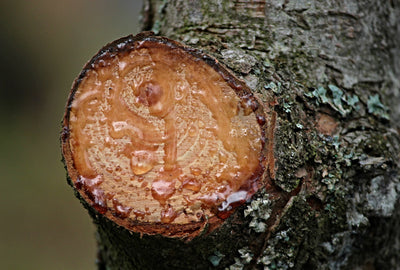What is latex? We answer this question in our favorite Materialguide. Regardless of whether plywood, acrylic, slate or Foam rubber. We inform you about your favorite materials.
On the one hand, the term latex refers to the latex of the rubber tree, from which natural rubber is extracted. On the other hand, in everyday language, latex also refers to natural rubber itself as well as its synthetic variants. Synthetic latex is made from petroleum. Depending on the area of application, certain latex properties must be present: The material can be foam-like or more reminiscent of a thin rubber skin. Latex is a stretchable and tear-resistant material that is very often used in the production of clothing and protective clothing. To produce natural latex, the latex sap is first skimmed off.
A mixture of milk juice and sulphur is then heated. This process is called vulcanization. Synthetic latex, on the other hand, is made from unsaturated hydrocarbons such as butadiene in the laboratory. During production, the material can be tailored precisely to its later intended use, which brings considerable advantages for the industry.
What is Latex: How is Latex made?

Natural latex is obtained from the rubber tree who grows in the tropics. Already the Maya knew around the lactic juice she was rushing and formed to balls. Later, the Aztecs used the juice of the "crying tree" to coat objects. Explorers like Christoph Columbus gave little attention to rubber. Only with Charles Goodyear and the development of vulcanization in the 19th century, the course could be placed for today's rubber production.

Before you can start with the latex crop, the tree must be at least five years old. The tree bark is cut obliquely. The juice flowing out of the tree trunk is collected in a container. A tree supplies around 20 g of milk juice per day - a third of which is latex, the rest is water. The lactic juice is acidified with vinegar or formic acid, whereby the magnetic rubber is scattered and rolled into shells.
Latex properties: What are the properties of latex?
At room temperature Is the material rubber-elastic. That is, the material always returns to its original state. In the natural rubber, the isoprene molecules are connected to each other in chain-shaped pills. By stretching the material, these balls are stretched and thus aligned in parallel. In a chemical process called vulcanization, sulfur bridges are used between the individual chains. This reduces the mobility of the chains. To deform the material, more power is needed.
What is Latex: What types of material exist?
A rough distinction is made between natural and synthetic latex. The former is obtained from the rubber tree, while the latter is distilled from petroleum.
Dunloplatex goes back to Charles Goodyear. This developed the so-called Dunlop procedure, in which the milk juice pitched to foam and then mixed with a gelling agent. Vulcanization is done by hot steam or hot water, so that the latex foam is elastic.
Talalaylatex is made without pockets. Likewise, one tries to do without chemical additives. Compared to the Dunlop procedure is that Talalay procedure Very complicated, but the end product is also a lot of high quality and costly. A mixture of air and carbon dioxide causes the latex to gel.
In addition, new procedures are developed continuously to improve the quality of latex. This is important above all for the mattress industry.
What is Latex: What is the difference between synthesis and natural latex?
In the past, latex was made from natural rubber. Today, natural latex is rarely found; synthetic latex is used much more frequently. However, 40% of the rubber produced worldwide is natural rubber. In certain industries, natural rubber has a clear advantage - for example, in the production of car tyres. In many areas, however, the synthetic variety has its advantages: The latex properties can be optimized in the laboratory. The starting products as well as the molecular structure are influenced to obtain a specific product. In this way, the material can be adapted to the respective application.

Synthetic rubber is produced from unsaturated hydrocarbons such as butadiene by radical polymerization. Various linkages occur in the process. The latex properties depend directly on the nature of these linkages. Just as with natural latex, fillers must be incorporated into synthetic latex to stabilize the product. A mixture of butadiene with styrene or acrylonitrile is popular. About 60% of the synthetic rubber produced around the world is styrene-butadiene rubber with a 25% styrene content. Compared to natural latex, synthetic latex is less affected by wear and tear and is also more resistant to ageing.
What is Latex: The origins of the syntheselatex
We have the German chemist and Nobel Prize winner Hermann Staudinger to thank for the production of synthetic latex. In 1920, he discovered that natural rubber is made up of very large molecules, high-molecular polymers. He called these molecules "macromolecules". Staudinger called the formation of these macromolecules through covalent linkages "polymerization". Previously, Staudinger had found a simple way to synthesize butadiene and isoprene, both starting products in the production of synthetic latex. Staudinger's research results paved the way for the production of numerous synthetic substances. In the 1940s, the brothers Joseph, Ansil and Leon Talalay invented the latex production process named after them.
Latex properties: What distinguishes natural latex?
In its raw form, natural rubber is very elastic and soft. On the whole, it has rather poor heat resistance: At temperatures around freezing point it hardens, at 150 °C it melts. When exposed to light and oxygen, the molecules disintegrate, causing the material to become brittle. It is therefore important to vulcanise raw rubber, as this is the only way to make the material durable. The double bonds present in the rubber molecule make vulcanisation possible at all, but are also responsible for the brittleness of the material.
Latex properties: How to use latex

Rubber and latex are used in many industries. Mattresses, yoga mats, conveyor belts, rubber boots and condoms are made of the material. But most rubber - Around 75% of world production - eliminates the production of car tires. Latex is constantly being researched to optimally adapt the material to the respective needs.
Nitrile rubber made of butadiene and acrylonitrile is used for auto seals, but neoprene is used in the production of diving atmospheres. Silicone rubbers occur in a particularly large variety. Each product is unique in its chemical composition and provided for a particular industrial branch. Silicone rubbers are extremely temperature-resistant and elastic. In addition, they are also very robust and have a long service life.
Latex cut easily made
Latex is versatile, for example for clothing or room decorations. The material webs must be cut into smaller pieces.
With our Mr Beam laser cutter you can cut latex effortlessly and precisely according to your wishes. Latex and natural latex can be cut easily with a material thickness of up to 1 mm. With our Laser machine you can also cut and engrave many other materials.



